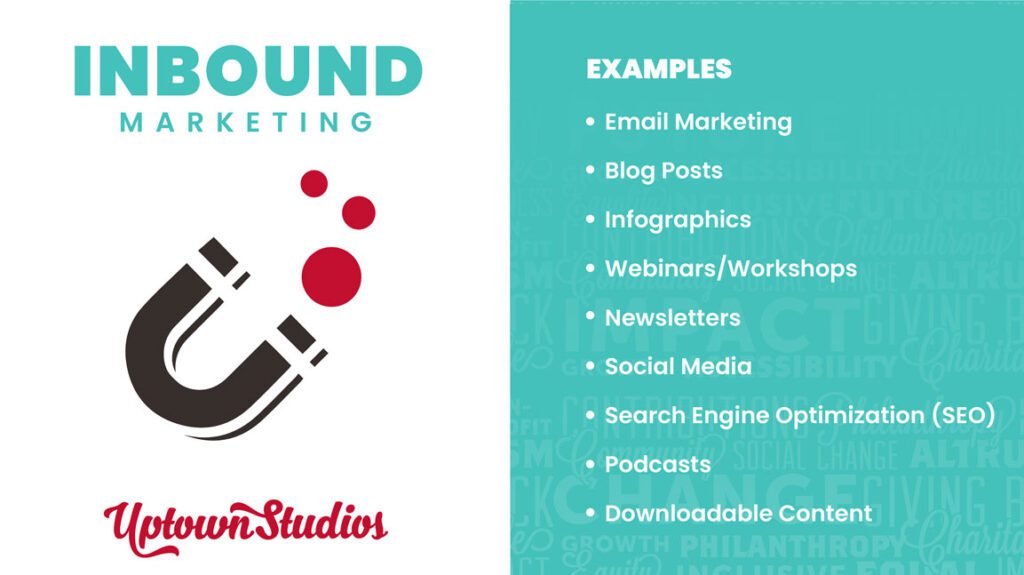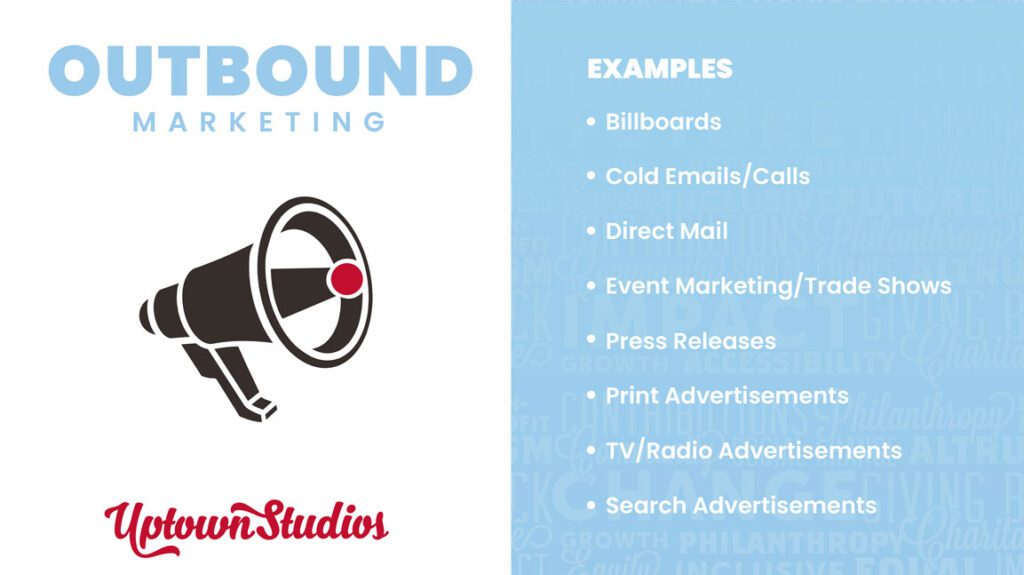
You’ve probably heard you need to implement both outbound and inbound marketing strategies to make the most out of your marketing efforts. But what exactly is the difference between the two? In this blog post, you’ll get a high-level overview of what they each entail so you can decide how you want to implement them to grow your small business.
What is Inbound Marketing?
Inbound marketing is a marketing strategy that utilizes engaging content to provide value for customers. Value can come in many forms such as educating people, helping people do things better and more efficiently, or simply giving people the tools to make better decisions. Inbound marketing content is different from outbound marketing content because its value cultivates trust between customers and the brand. When you provide content that addresses the needs of your ideal customer, you attract the right leads and build credibility for your business.
This type of marketing is typically slower at generating leads, but the rewards can be high and long-lasting. Business leads include any person who is interested in the service or product you provide, but have not yet become a customer or client.

Examples of Inbound Marketing:
- Email Marketing
- Blog Posts
- Infographics
- Webinars / Workshops
- Newsletters
- Social Media
- Search Engine Optimization (SEO)
- Podcasts
- Downloadable Content
Inbound marketing uses a methodology comprised of three components:
- Attract: The first stage is designed to draw in prospects by offering content that informs them about your business offerings and directs them to your website. You should provide value and promote yourself as a trusted business. For example, you could send a newsletter via email that introduces your business and also provides free tips regarding a relevant and related topic.
- Engage: Once a prospective customer interacts with your business, you need to present solutions that align with their pain points. A pain point is a specific problem that your lead is experiencing. Additionally, it is also important to present the right call to action in order to convert the lead into a customer. For example, once a lead is rerouted from your newsletter to a landing page (a designated page on your website), you could provide clear solutions offered by your business. Additionally, the lead needs to explicitly be told what action to complete next, such as “call us for a quote” or “sign up for one of our plans”.
- Delight: The third stage is where you provide the customer with help and support so that they are satisfied with their service, purchase, and overall experience. Doing this will give the customer a reason to return and promote your business to other people. For example, you could provide the customer/client with information on frequently asked questions or other tools that will assist them. You could also ask for feedback on ways to improve their experience.
What is Outbound Marketing?
Outbound marketing is a traditional form of marketing. Unlike inbound marketing that “pulls” in customers/clients seeking your solutions, outbound marketing “pushes” messages out to customers/clients in order to draw them in. This type of marketing can be expensive since its purpose is to find customers/clients by casting a wide net. However, it can be very effective at pulling in new customers and might allow you to see results much faster than inbound marketing.

Examples of Outbound Marketing:
- Billboards
- Cold Emails/Calls
- Direct Mail
- Event Marketing / Trade Shows
- Press Releases
- Print Advertisements
- TV/Radio Advertisements
- Search Advertisements
Pros and Cons
Now that you have a general understanding of both marketing techniques, let’s take a look at each side by side. When evaluating the pros and cons of each technique, consider the resources available to your business.
| Inbound Marketing | Outbound Marketing | |
| Pros | Lower cost
Return On Investment (ROI) is typically higher Relationships created are long-lasting Positions your business as a credible source of information |
Generates results faster
Reaches a larger audience Targets and reaches people who may not know about your business |
| Cons | Slower at generating leads
Content creation can be time-consuming Many channels and platforms to manage Digital trends are constantly changing |
High cost
More difficult to track ROI Blocking techniques (spam filters, ad blockers, do not call lists) can limit exposure Audience may not be ready to become a customer/client when they receive your message |
Which marketing strategy is best for my business?
The purpose of both marketing strategies is to grow your business which could mean increasing sales or simply reaching more people. Inbound marketing is typically more effective and provides a higher ROI. However, outbound marketing is still a useful tool that can ensure you maximize all marketing efforts. You cannot simply rely on people seeking out your solutions. The best marketing strategies usually combine both approaches and tailor them to fit a specific business’s needs, while staying within the available resources.
Need some help with your inbound or outbound marketing? Holler at us!
Blog


